
Locality: Palermo Mine, N. Groton, NH
Specimen Size: 4 mm field of view
Field Collected: Walter Lane - from material purchased by the Micromounters of New England
Catalog No.: u1316
Notes: Jim Nizamoff thought paravoxite was the most likely species for this specimen.
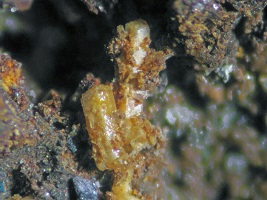
Locality: Palermo Mine, N. Groton, NH
Specimen Size: Pair of paravauxite rhombic prisms. Crystal on left is 1.0 mm.
Field Collected: From a small box of small rock chunks gifted by Bob Whitmore
Catalog No.: u1513
Notes: Photo is from a "stack" of 8 images processed with Helicon Focus.
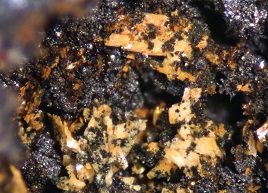
Locality: Chickering Mine, Walpole, NH
Specimen Size: 3 mm field of view
Field Collected: Bob Wilken
Catalog No.: A Bob Wilken specimen and photo
Notes: Cream-colored paravauxite crystals. A visual ID.
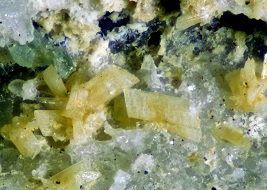
Locality: Rice Mine, N. Groton, NH
Specimen Size: 3 mm field of view
Field Collected: Clayton Ford ±1970
Catalog No.: A Bob Wilken specimen and photo
Notes: Phosphate minerals are relatively uncommon at the Rice Mine.
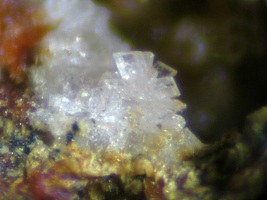

Confidence: 4 (paravauxite or sigloite - see notes)
Chemistry: Fe2+Al2(PO4)2(OH)2 · 8H2O
Locality: Chickering Mine, Walpole, NH
Specimen Size: 0.5 mm paravauxite cluster. Individual crystals on the order of 0.1 mm.
Field Collected: Tom Mortimer
Catalog No.: u1336
Notes: First EDS analysis (by analyst Kerry Day) suggested the species is a member of the stewartite group, sigloite being the best fit, with moderate Mn substitution.
The morphology of these crystals are a good match with the sigloite specimen examples shown on mindat.
In November 2017, Jim Nizamoff opined that paravauxite may be a better identification than sigloite for these small clear crystals. Jim explained, when tri-valent iron is present (as in sigloite), it is less likely to produce a colorless crystal. An EDS analysis giving element atomic percents would be helpful to determine the Mn:Fe ratio, but will shed no light on the Fe oxidation state. Fortunately, I have four specimens that could provide grains.
A follow-up EDS analysis with quantification, (BC375 Set 27) computed a chemistry of
(Fe0.57, Mn0.23)Al1.56P2O57 , normalized for 2 P. This is consistent with the Kerry Day analysis above.
At the January, 2020 MMNE meeting, I acquired a Janet Cares Bolivian paravauxite from the type locality. An EDS analysis of a grain from this specimen, side-by-side with the u1336 grain, computed a chemistry of Fe0.62Al1.67P2O21 , also normalized for 2 P. Interesting, the Fe and Al are also low for a paravauxite, and close to the Chickering analysis values.
These two photos are both with a Canon G9 camera: Top photo with Meiji trinocular scope, bottom photo with Nikon Plan 10/0.25 objective lens, (better) .

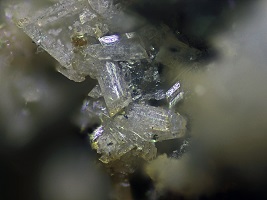
Locality: Palermo Mine, Groton, NH
Specimen Size: 0.5 mm field of view
Field Collected: Tom Mortimer
Catalog No.: TBC
Notes: Paravauxite is uncommon at the Palermo Mine. I made four attempts to photo this. Very small. None were particularly good. Motivated by rarity of species at Palermo.
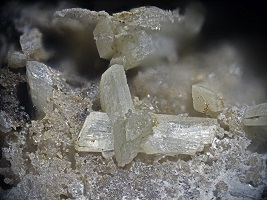
Locality: Fletcher Mine, Groton, NH
Specimen Size: 7 mm field of view
Field Collected: Bob Janules
Catalog No.: A Bob Janules specimen
Notes: About as nice a NH paravauxite as I have seen.